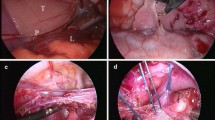Abstract
Purpose
Posterior tracheopexy has been proposed as a novel approach to treat tracheobronchomalacia, in addition or alternative to more traditional treatments as aortopexy. Reports on this technique are still very sporadic. Our aim is to discuss technical surgical details based on our preliminary experience of thoracoscopic and robotic posterior tracheopexy.
Methods
Technical details on 6 patients (from 8 months to 13 years of age) operated for posterior tracheopexy with a thoracoscopic approach are presented and discussed. In two cases robotic posterior tracheopexy was performed.
Results
Two patients presented multiple comorbidities and had a tracheostomy previously performed. Airway obstruction evaluated at pre-operative bronchoscopy was between 70 and 100%, with posterior intrusion of pars membranacea. Operative time ranged from 110 to 320 min. In three cases aortopexy was associated, one at the same time, in the other two before or after tracheopexy. No specific complications of posterior tracheopexy were observed. Robotic approach made the esophageal dissection and the tracheobronchopexy technically easier.
Conclusion
Thoracoscopic approach is feasible, robotic assistance is helpful for improving visualization, esophageal dissection, and making easier and more precise the pexy of the trachea and bronchi on all its length. Both bronchi can be approached and pexied if necessary, and this is a specific advantage of tracheopexy with respect to aortopexy. Intraoperative bronchoscopy and strict collaboration between surgeons and anesthesiologists are essential.



Similar content being viewed by others
References
Shieh HF, Smithers CJ, Hamilton TE, Zurakowski D, Rhein LM, Manfredi MA, Baird CW, Jennings RW (2017) Posterior tracheopexy for severe tracheomalacia. J Pediatr Surg 52(6):951–955
Dewberry L, Wine T, Prager J, Masaracchia M, Janosy N, Polaner D, DeBoer E, Somme S (2019) Thoracoscopic posterior tracheopexy is a feasible and effective treatment for tracheomalacia. J Laparoendosc Adv Surg Tech A 29(10):1228–1231
Kamran A, Yu R, Hamilton T, Nath B, Zendejas B, Jennings R, Smithers C (2018) First report of robot-assisted thoracoscopic posterior tracheopexy to treat severe tracheomalacia. J Laparoendosc Adv Surg Techn A. 28:6
Wallis C, Alexopoulou E, Antón-Pacheco JL, Bhatt JM, Bush A, Chang AB, Charatsi AM, Coleman C, Depiazzi J, Douros K, Eber E, Everard M, Kantar A, Masters IB, Midulla F, Nenna R, Roebuck D, Snijders D, Priftis K (2019) ERS statement on tracheomalacia and bronchomalacia in children. Eur Respir J 54(3):1900382
Masters IB, Chang AB (2005) Interventions for primary (intrinsic) tracheomalacia in children. Cochrane Database Syst Rev 10:CD005304
Torre M, Carlucci M, Speggiorin S, Elliott MJ (2012) Aortopexy for the treatment of tracheomalacia in children: review of the literatura. Ital J Pediatr 38:62
Tytgat SHAJ, van Herwaarden-Lindeboom MYA, van Tuyll van Serooskerken ES, van der Zee DC (2018) Thoracoscopic posterior tracheopexy during primary esophageal atresia repair: a new approach to prevent tracheomalacia complications. J Pediatr Surg 53(7):1420–1423
Polites SF, Kotagal M, Wilcox LJ, de Alarcon A, Benscoter DT (2018) von Allmen D Thoracoscopic posterior tracheopexy for tracheomalacia: a minimally invasive technique. J Pediatr Surg 53(11):2357–2360
Masaracchia MM, Polaner DM, Prager JD, DeBoer EM, Dewberry LC, Somme S, Wine T (2018) Janosy NR Pediatric tracheomalacia and the perioperative anesthetic management of thoracoscopic posterior tracheopexy. Paediatr Anaesth 28(9):768–773
Funding
No funding.
Author information
Authors and Affiliations
Contributions
All authors contributed to the study conception and design. Material preparation, data collection and analysis were performed by VG, FL, FP. OS is the pulmonologist who evaluated bronchoscopically the patients before the surgery and during the procedure. GM and MT were the surgeons who performed the procedures, ND and AM the anesthesiologists and intensivists who took care of the patients in the peri-operative period. PP is the CEO of our Institute, who made it possible to have robot in our pediatric Institute. The first draft of the manuscript was written by MT and all authors commented on previous versions of the manuscript. All authors read and approved the final manuscript.
Corresponding author
Ethics declarations
Conflict of interest
Authors have not conflict of interest to be disclosed.
Ethics approval
The study does not include any study on patients.
Rights and permissions
About this article
Cite this article
Torre, M., Guerriero, V., Moscatelli, A. et al. Posterior tracheobrochopexy with thoracoscopic or robotic approach: technical details. J Ped Endosc Surg 2, 169–174 (2020). https://doi.org/10.1007/s42804-020-00082-6
Received:
Revised:
Accepted:
Published:
Issue Date:
DOI: https://doi.org/10.1007/s42804-020-00082-6




